Scientists at Stanford University have made significant strides in medical imaging by developing a method to render mouse skin and tissues transparent using tartrazine, a common food dye. This breakthrough, published in the journal Science, enables researchers to observe blood vessels and organ functions without invasive procedures. By applying tartrazine as an ointment, the team's innovative approach alters the refractive index of the skin, allowing for improved visibility of internal structures. This technique not only holds promise for enhancing preclinical experiments and surgeries but also opens doors for non-invasive medical diagnostics.
The transparency effect is achieved by combining tartrazine with skin, which acts as a scattering medium. The dye absorbs blue and ultraviolet light while allowing red light to pass, effectively matching the refractive indices of the skin and the dye solution. Remarkably, the effect is reversible, as the dye can be washed away, restoring the skin's opacity without harm. Researchers are currently exploring the application of this technology in humans, as well as testing other molecules that could enhance the transparency effect.
This innovative technique could revolutionize medical practices, reducing the need for painful surgeries and enabling real-time observation of internal processes. The researchers emphasize the non-toxic nature of tartrazine, which is widely used in the food industry, making it a safe option for potential medical applications. As they continue their work, the Stanford team aims to patent their technology, which may significantly improve surgical procedures and diagnostics in the future.
- The research team led by Zihao Ou has successfully demonstrated the use of tartrazine in making mouse tissues transparent, which could have far-reaching implications in the fields of biology and medicine. The study highlights the importance of refractive index matching in achieving transparency, a concept that challenges conventional understanding of how light interacts with different materials.
- The researchers are also investigating the possibility of utilizing other dyes and substances that may offer similar or improved transparency effects. While the current findings are promising, further studies are needed to determine the feasibility and safety of applying this technique in human subjects, given the differences in skin thickness and composition.
- In addition to its medical applications, the transparency technique could provide new opportunities for research in various biological models, expanding the potential for live observation of internal processes in different species. The implications of this research extend beyond mere curiosity, as it paves the way for advancements in non-invasive medical technologies.






